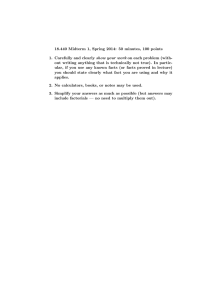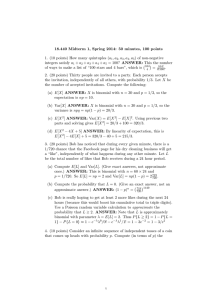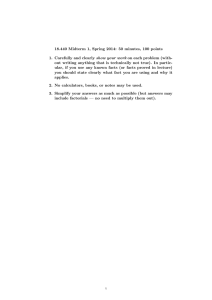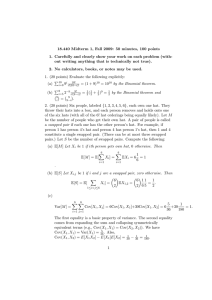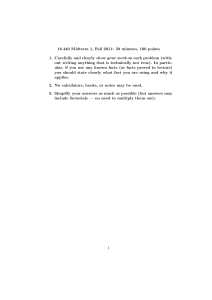18.440 Midterm 1, Spring 2014: 50 minutes, 100 points , a
advertisement
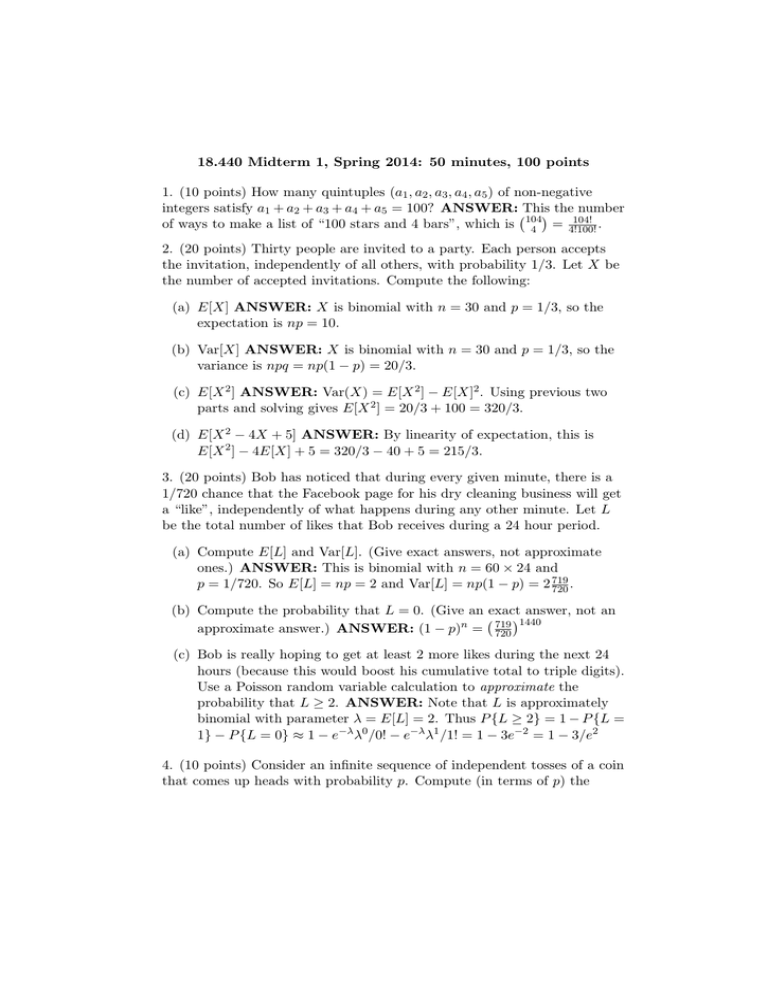
18.440 Midterm 1, Spring 2014: 50 minutes, 100 points
1. (10 points) How many quintuples (a1 , a2 , a3 , a4 , a5 ) of non-negative
integers satisfy a1 + a2 + a3 + a4 + a5 = 100? ANSWER: This
number
the104!
104
of ways to make a list of “100 stars and 4 bars”, which is 4 = 4!100! .
2. (20 points) Thirty people are invited to a party. Each person accepts
the invitation, independently of all others, with probability 1/3. Let X be
the number of accepted invitations. Compute the following:
(a) E[X] ANSWER: X is binomial with n = 30 and p = 1/3, so the
expectation is np = 10.
(b) Var[X] ANSWER: X is binomial with n = 30 and p = 1/3, so the
variance is npq = np(1 − p) = 20/3.
(c) E[X 2 ] ANSWER: Var(X) = E[X 2 ] − E[X]2 . Using previous two
parts and solving gives E[X 2 ] = 20/3 + 100 = 320/3.
(d) E[X 2 − 4X + 5] ANSWER: By linearity of expectation, this is
E[X 2 ] − 4E[X] + 5 = 320/3 − 40 + 5 = 215/3.
3. (20 points) Bob has noticed that during every given minute, there is a
1/720 chance that the Facebook page for his dry cleaning business will get
a “like”, independently of what happens during any other minute. Let L
be the total number of likes that Bob receives during a 24 hour period.
(a) Compute E[L] and Var[L]. (Give exact answers, not approximate
ones.) ANSWER: This is binomial with n = 60 × 24 and
p = 1/720. So E[L] = np = 2 and Var[L] = np(1 − p) = 2 719
720 .
(b) Compute the probability that L = 0. (Give an exact answer, not an
1440
approximate answer.) ANSWER: (1 − p)n = 719
720
(c) Bob is really hoping to get at least 2 more likes during the next 24
hours (because this would boost his cumulative total to triple digits).
Use a Poisson random variable calculation to approximate the
probability that L ≥ 2. ANSWER: Note that L is approximately
binomial with parameter λ = E[L] = 2. Thus P {L ≥ 2} = 1 − P {L =
1} − P {L = 0} ≈ 1 − e−λ λ0 /0! − e−λ λ1 /1! = 1 − 3e−2 = 1 − 3/e2
4. (10 points) Consider an infinite sequence of independent tosses of a coin
that comes up heads with probability p. Compute (in terms of p) the
probability that the fifth head occurs on the tenth toss. ANSWER: This
is the probability that exactly four of the first nine tosses are heads, and
then the tenth toss is also heads. This comes to 94 p5 (1 − p)5 .
5. (20 points) Let X be the number on a standard die roll (assuming
values in {1, 2, 3, 4, 5, 6} with equal probability). Let Y be the number on
an independent roll of the same die. Compute the following:
(a) The expectation E[X 2 ]. ANSWER:
(1 + 4 + 9 + 16 + 25 + 36)/6 = 91/6.
(b) The expectation E[XY ]. ANSWER: By independence of X and Y ,
we have E[XY ] = E[X]E[Y ] = (7/2)2 = 49/4.
(c) The covariance Cov(X, Y ) = E[XY ] − E[X]E[Y ]. ANSWER:
Because of independence, Cov(X, Y ) = 0.
6. (20 points) Three hats fall out of their assigned bins and are randomly
placed back in bins, one hat per bin (with all 3! reassignments being
equally likely). Compute the following:
(a) The expected number of hats that end up in their own bins.
ANSWER: Let Xi be 1 if ith hat ends up in own bin, zero
otherwise. Then X = X1 + X2 + X3 is total number of hats to end
up in their own bins, and E[X] = E[X1 ] + E[X2 ] + E[X3 ] = 3 13 = 1.
(b) The probability that the third hat ends up in its own bin.
ANSWER: 1/3
(b) The conditional probability that the third hat ends up in its own bin
given that the first hat does not end up in its own bin. ANSWER:
Let A be event third hat gets own bin, B event that first hat does
not end up in its own bin. Then P (A) = 1/3 and P (B) = 2/3. There
is only one permutation that assigns the third hat to its own bin and
does not assign first hat to its own bin, so P (AB) = 1/6. Thus
P (A|B) = P (AB)/P (B) = (1/6)/(2/3) = 1/4.
